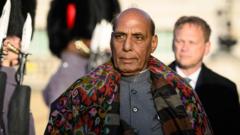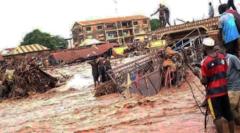The relentless monsoon season that began in late June is wreaking havoc as at least 57 lives have been lost, with heavy rain causing flooding in numerous cities and rural areas. According to the National Disaster Management Authority, many victims included children, with casualties primarily due to collapsing buildings.
Flooding in Pakistan: Devastating Monsoon Rains Claim Lives

Flooding in Pakistan: Devastating Monsoon Rains Claim Lives
Severe monsoon rains in Pakistan have resulted in tragic fatalities and widespread destruction, with heavy impacts reported across Punjab province.
The floods, which commenced on Wednesday, submerged several villages in Punjab, Pakistan's most populous province, and inflicted significant damage to infrastructure, including power lines. Areas like Chakwal, located approximately 60 miles south of the capital Islamabad, are among the hardest hit, with local residents reporting their homes and crops being swept away. One farmer, Malak Jamil, shared his distress regarding the $6,000 loss he estimated from the flooding, saying, "I have no idea how I will recover from this."
With road access to many communities cut off, the Pakistani military has dispatched helicopters to rescue individuals stranded by the floodwaters. Residents in low-lying areas are being urged to evacuate to higher ground promptly when warned. Fortunately, the Pakistan Meteorological Department has forecasted a break in the torrential rains, which may provide temporary relief.
Deaths from electrocution have also been reported due to the inundation of power lines and electrical appliances. UNICEF has issued a stern warning about the heightened risks faced by children from drowning, disease, and electrocution posed by the floods.
Experts have established connections between the escalating frequency and severity of flooding events in Pakistan and climate change, particularly as computer models suggest that rising temperatures have intensified rainfall patterns during the monsoon period, expected to last from July to September. The catastrophe echoes last year's monsoon season, which saw over 1,700 fatalities and millions displaced, reflecting a devastating trend.
As the monsoon season progresses, disaster management officials have pointed to the alarming rate of glacier melting in northern Pakistan as a contributing factor to the flooding crisis.
With road access to many communities cut off, the Pakistani military has dispatched helicopters to rescue individuals stranded by the floodwaters. Residents in low-lying areas are being urged to evacuate to higher ground promptly when warned. Fortunately, the Pakistan Meteorological Department has forecasted a break in the torrential rains, which may provide temporary relief.
Deaths from electrocution have also been reported due to the inundation of power lines and electrical appliances. UNICEF has issued a stern warning about the heightened risks faced by children from drowning, disease, and electrocution posed by the floods.
Experts have established connections between the escalating frequency and severity of flooding events in Pakistan and climate change, particularly as computer models suggest that rising temperatures have intensified rainfall patterns during the monsoon period, expected to last from July to September. The catastrophe echoes last year's monsoon season, which saw over 1,700 fatalities and millions displaced, reflecting a devastating trend.
As the monsoon season progresses, disaster management officials have pointed to the alarming rate of glacier melting in northern Pakistan as a contributing factor to the flooding crisis.




















